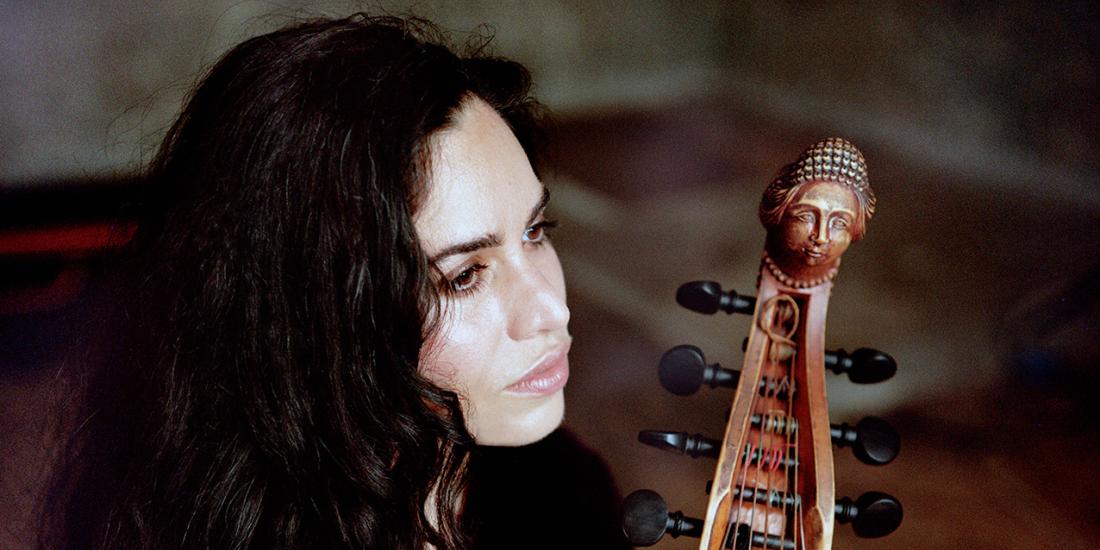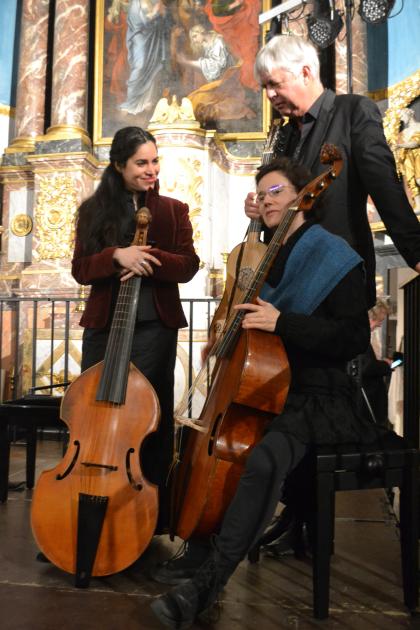Philippe Pierlot is unable to perform as he is on tour with Jordi Savall and Hespèrion XXI. He has entrusted you with preparing this concert — a sign of real trust.
It’s an honour and a huge responsibility to take the reins of the Ricercar Consort, especially in Belgium and at Bozar. Philippe lets me make my own choices and to be the musician I want to be. He is an unorthodox and legendary violist from whom we keep learning, especially in terms of phrasing. You don’t just learn at the conservatory, but also by performing with others. I am delighted to be part of his musical family and am fortunate to be a disciple.
How did Monsieur de Sainte-Colombe et ses filles come about?
Sainte-Colombe is a legendary musician, known mainly for having written music for several viols. He would perform this music with his two daughters during private concerts at his home. In 2016, we had the idea to make a recording where Philippe Pierlot would play the part of Sainte-Colombe, Myriam Rignol and I would play the two daughters, and Rolf Lislevand would play the lute. We also included some works by Sainte-Colombe’s contemporaries such as Louis Couperin and Chambonnières, and consort arrangements of original works for the harpsichord, which was widely done at the time.
“You don’t just learn at the conservatory, but also by performing with others.”
How did you adapt the record to the stage?
I prepared a new programme, inspired by the record. We kept the consort for three viols with lute (with the participation of Clémence Schiltz, a former student of Philippe Pierlot) as well as the French repertoire. Myriam Rignol and I had the idea of going back to the 16th century. We found it interesting to include Du Caurroy’s fantasies for three viols, which are rarely played. We also have Forqueray and his suite for three viols; it is incomplete but very beautiful. Sainte-Colombe’s La volontaire is new for me, while Caligie is a superb piece that we’ve already played with Philippe. There is, of course, Marin Marais, and also Louis Couperin, with a Passacaille for harpsichord which we transcribed for the viols.
What characterises these composers?
They are all unusual. Du Caurroy is still in the tradition of French polyphony, with three equal voices. Sainte-Colombe does not fit into a category or school. He evolved outside the court and remained impervious to the conventions of the time. He is stands out from the rest. In his music, voices constantly intertwine, responding to his own unique logic, which is neither horizontal nor vertical.
How does this translate into music?
Sainte-Colombe makes use of all the viol’s harmonic properties. He uses melodies but also chords played individually by each musician. Sometimes he overlaps chords that are not meant to sound good together: you could even speak of clusters! This is what makes his style so unique. You end up with a very dense fabric. For Du Caurroy, on the other hand, each voice has its own range. There are very few crossovers.
“Sainte-Colombe stands out from the rest. He creates music that is totally sincere, that takes you by the guts.”
So, musical pleasure lies in this interweaving polyphony?
Absolutely, the work of the sound on the viol is the essence of this music. This is particularly the case with Sainte-Colombe, whose intimate music was never intended to please the court. His music is uncompromising, gripping and utterly heartfelt. Marin Marais, on the other hand, is a man of the court: you can feel it in his more standardised music. But it’s still marked by the pleasure of performing, and by chamber music.
We need to remember that all these composers were themselves instrumentalists. For example, Louis Couperin played the viola da gamba at the court of Louis XIV. They were all very familiar with the physical intricacies of the instrument, which gives the sound and textures a sensual quality.
Making music for a domestic setting, removed from social expectations: it is almost a political statement.
Entire legends have surrounded Sainte-Colombe, and it can sometimes be hard to distinguish fact from fiction. But even if we set aside the fictional aspect of Tous les matins du monde and its film adaptation, we are still faced with an unusual character. His music was never published; it was probably never intended for a wider audience. What’s more, his manuscripts contain many oddities, and we often don’t know if they are mistakes or deliberate quirks.
Did the film Tous les matins du monde play a role in your musical journey?
When the film came out, I was five or six and I was already playing the viol. I was lucky to grow up in a family that played period music. The viol was not an unusual instrument for me. I went to see the film — a version that my mother had forbidden me to see — and I really liked it. I listened to the film’s soundtrack, recorded by Jordi Savall, at home. I think that as a result of the film, many viola da gamba classes appeared in conservatories. Nowadays, more and more young people are taking up the instrument, sometimes at very proficient levels!
What are your other projects?
Belgium seems to suit me, since I’m currently recording a record for Alpha Classics: a trio with Olivier Fortin and Simon Pierre, in Flagey, featuring 18th century French music. I’m also preparing a new solo record featuring 17th century German music, as well as concerts around my latest record, Abel-Bach. There’s also some contemporary music, with several creations for solo viol. This work raises a whole series of questions about the specific potential of this instrument: it’s very different from early music, but it complements it well!

